Matthew J. Osborn, University of Pennsylvania
(Published May 3, 2018)
Abstract: This essay performs a "glitching" of the scholarly article by enacting sonic aesthetics heard during the electronic dance music buzz of the early twenty-tens. Its purpose is to situate timbre as a rhetorical parameter within a hybrid of musical and sonic rhetorics discourses. As a case study, textures and timbres from "dubstep" productions are presented here as modalities through and during which to perform thinking about sonic phenomena. While the essay sketches a preliminary "sonic rhetoric of electronic dance music," it rebegins when excursions toward experimental strains of music historically recognized as "noise," "glitch," and "failure" are themselves "glitched" into the article's sequence. The piece closes by refuting, on the basis of timbre, the common critique of electronic dance music as mere product for popular audiences devoid of aesthetic innovation. Audio samples appear throughout the text and may be cued by mousing-over images below.
Prelude
A curious silence surrounds our relationship with sound. The terms "timbre" and "tone color" refer to the idiosyncratic character of different instruments playing the same note, which at once associates the concepts with both the singular and the relative. A trombone's texture differs from a ukulele's, of course, and a sitar sounds different than a gong. Yet these deceptively simple differentiations pose virtually limitless opportunities and challenges for the very possibility of knowing what or how a particular sound sounds. For all this, timbre plays a relatively quiet and ambiguous role in music theory, whose primary focus is relatively mathematized parameters like tonality, harmony, pitch, meter, rhythm, and notation.1 As we will hear, this conundrum presents an opportunity for sonic rhetoric to learn something about itself from two mercurial movements: namely experimental and electronic dance music.
Although much valuable work is available on authorship, sampling, and remixing in digital music, the aesthetic textures and affective experience of experimental and dance genres are also worth exploring as sonic-rhetorical parameters. Specifically, attending to impulses in recent electronic dance music (EDM) known as "dubstep" alongside related sensibilities in rhetoric gives the field fresh ways to engage sonic experiences as objects of study. Aesthetics and rhetorics of recent EDM—music which, for some critics, is assaulting noise—can contribute to conversations in rhetoric increasingly concerned with the sonic dimension as a fruitful variable for rhetorical affect, the possibility of writing as something beyond or other than representation, complications of the split between subject and object, and performative argumentation.
The article's primary contribution is a performative exploration of the rhetorical-aesthetic interactions among listeners and sonic texture. At issue is the concept of so called "objects" of study in scholarly discourse and, specifically, our relationships with sonic "objects." I surmise that rhetoric can not only acknowledge this disjuncture, but perform it as well. To establish such offerings, this essay will provide and yet surpass a "sonic rhetoric of electronic dance music" to demonstrate blur and bleed between epistemic and aesthetic registers in, during, and apropos of the performance that is academic work (and, more generally, thought). While the electronic music is not incidental, the broader idea is that challenges presented by liminal text(ure)s can help reveal that the critical manuscript is itself a framework or particular way of knowing that yields both gains and losses for sound studies.
Sonic rhetoricians Steph Ceraso and, separately, Katherine Fargo Ahern have crafted innovative ways of relating to the experience and meaning of sound. Their work takes important steps toward renewed relationships with timbre, and applications of their thinking appear below. Before them came the pioneering efforts of Jody Shipka, Cynthia Selfe, and Bump Halbritter, who in different ways sought to introduce the sonic as a legitimate mean of persuasion in multimodal scholarship that historically favored visuality and the image. A number of scholars have also taken genres of music as models or inspiration for writing, rhetoric, and/or composition scholarship as well as pedagogies. Here I am thinking of Jeff Rice, who hears in rap and hip-hop's sampling and re/mixing means by which to rearrange or depart entirely from rhetorical topoi as the sole or dominant guide for invention. One also thinks of Michael Jarrett, who exalts the improvisation of jazz as a technique for composition writ large. Byron Hawk's listening sessions with experimental punk lead him to suggest that music can not only reflect or respond to a culture or a world, but can also create worlds and thus have a "worlding" capacity (more on this below). And there is Thomas Rickert, whose book hears and feels ambient music as a metaphor for an ambient rhetoric, which displaces the field's longstanding emphases on salience and intentionality, "boost[ing] the importance of indirect, unconscious, auratic, osmotic, and ambient phenomena" (154) as atmospherically suasory. I sense a comparable and yet distinct exigence in, through, and during the temporal and affective experience of electronic dance music.
While I begin to trace a rhetoric of dubstep in a grammatical or generic sense below, I also pursue the rewards and necessity of the relationships that rhetors and audiences have with the music. In other words, more than simply discoursing "about" the genre will be required in order to engage the aesthetic and affective experience of such auralities to do fitting service for this music and culture that, as we will hear, prioritizes innovative timbres and singularities of textures over traditional generic attributes. EDM has no monopoly on artistic experimentation, of course, and I hope the discussion of timbre in this essay may be extended or applied to other genres and sonic rhetoric at large. But, as we will hear, dubstep's emphasis on idiosyncratic and novel textures make it a good case study for the aesthetic and affective experience of music as sound in general.
Electronic dance music has long, diverse, and international histories. "Dubstep," one particular strain in the ecology of EDM writ large, has recently garnered near mainstream attention. Although this cross-section of EDM varies dramatically from artist to artist, dubstep might be loosely characterized by its relatively slow tempo of approximately 140 beats per minute, generic structural patterns (e.g., "builds," "drops," "interludes"), digitally synthesized sounds, and recurring themes of its occasional lyrical content. Sonically, listeners get a dis/array of baroque, modulated, and sometimes atonal combinations of sounds. Samples can be heard throughout this article by hovering over images below.

Clip 1: Datsik, "Hydraulic" (2011).
The artist is known to perform inside a projection screen shaped like a subwoofer.
Image: "Datsik_Digital_Assassins_3243" by Nick Ford / CC BY-NC-ND 2.0.
Reductive accounts of dubstep sometimes exclude it from the realm of pleasure altogether, condescending to the disjunctive aesthetics, timbres, and moods of the genre. One New York Times reviewer describes a dubstep concert as "almost all tremor":
That there's no dance music less sensuous than this was not an obstacle. Dubstep can often sound like the gears of an industrial thrasher groaning from overuse, or the soundtrack to the construction of a Richard Serra steel sculpture. (Caramanica)
Notable for me is the very notion that such textuality or textural experience, at least for fans, is desirable in the first place—especially given that such arts experienced windfall of attention never before associated with related genres. While electronic dance music is by no means new, its recent inclusion in mainstream culture is. Artists like Skrillex, 12th Planet, and Datsik have enjoyed a recent boom of international listenership and achieved unprecedented commercial success in polymorphous genres like dubstep, drum and bass, and electro-house.2 In this essay, I focus on American, Canadian, Northern European, and Australian varieties of dubstep music produced from approximately 2010 to 2015. The focus will be relatively new and noisy varieties of dubstep whose roots are in artists like UK producers like Skream, Burial, and Rusko, who in turn are indebted to actual "dub" music, or "reggae dub." Tracing this history in the detail it deserves is beyond the scope of the present writing, but suffice it to say the focus of this article is a whole new breed of artists including, yes, Skrillex, but also others such as SKisM, Krewella, Kill the Noise, Adventure Club, KOAN Sound, Butch Clancy, and many more whose era is to be carefully distinguished as its own polymorphous, evolving movement within the broader EDM context. The attempt for the present essay is to consider genres as means or modalities with which to perform academic thinking during the sonic rhetorics movement more broadly.
Intentions, Intent, Performance
In The Postmodern Condition, Jean-François Lyotard uses a metaphor of soapy water to illustrate an epistemological architecture that was stochastic in its inter- and trans-disciplinary fusions, relations, and influences (58). He describes the state of knowledge as a kaleidoscopic series of generations and reorganizations, mapped as an incredible complexity of geometry in flux at all times. Rather than the "performativity" Lyotard associates with mastery of already established procedures, he suggests the new means by which knowledge is to be invented is "paralogy," or the invention of new knowledge-making procedures (44 ff.). The Report on Knowledge he sketched was spastic, proffering a "postmodern science as a search for instabilities" that would yield "singularities and 'incommensurabilities'" necessarily out of sync with the methods and procedures of the day (53, 60). I notice strikingly dis/similar energies, impulses, and aesthetics in EDM and dubstep in particular.

Clip 2: Skrillex, "Rock 'n Roll (Will Take You to the Mountain)" (2012).
Image: "Skrillex" by DIG Boston / CC BY 2.0. Cropped from original.
The music suggests aesthetic liminality in its apparent sensibility for texture and timbre itself—not instead, but in addition to the intelligibility of meter, rhythm, melody, progression, and lyrical content typical of popular Western music. We hear baroque arrangements of flotsam and jetsam alongside cracks and pops fractions of a second in duration. We hear flirtations with atonality and a primarily percussive experience. It may be that part of the aesthetic pleasure in electronic dance music cultures comes partly from a forfeiture of control, as listeners are awash in timbres for which they need not account as part of a melody or progression. While some hear noise, others sense perceptual dilations and a renewed sense of relation to music itself. Counting myself among the latter group, I am in agreement with Jeff Rice's contention that "to listen is not to seek out a truth; it is to engage with the process of knowing as opposed to just the known" (267, original emphasis).3 To suggest listening is an activity perhaps not fully distinct but, in a certain sense, distinguishable from a state of knowing is to underscore listening's processual, temporal, and even existential dimensions of inquiry typically unacknowledged or downplayed when the scholarly text is limited to propositional content.
I therefore engage in both critical and "post-critical" discussions to discuss, perform, and engage electronic dance music. My attempt will be to take up what Gregory L. Ulmer describes as a "relation of the critical text to its object of study to be conceived in terms no longer of subject-object but of subject-predicate" ("Object" 86). It could be argued that EDM cultivates an aesthetic of surprise related in spirit to Ulmer's oft-cited work on collage and montage, a stammering comparable to historiographical shifts in the discourse of human arts and sciences as recollected by Michel Foucault, and a wobble we might associate with recursive and self-reflexive discourse. Indeed, for starters, I make and support these claims before demonstrating the ease with which these interpretations can and should be surpassed by an enactment of the music—beyond an account of its salient features.
Alternative relationships with sound and music are already underway in the fields of rhetoric and composition. Steph Ceraso's breakthrough article, for example, argues that listening is a "multisensory act" and hence its rhetorical weight should not be limited to translating the sonic into the semiotic (104). She interrogates what she calls the “ear-centric” model of listening, which privileges the decryption of sounds as mere vehicles for content—an overdose of which, she argues, may diminish the embodied experience of sound (118). Transposed for timbre, Ceraso's impact is that sound need not be limited to its supposed "meaning"—that sonic meaning exceeds signification of known signifieds. For her, the corporeal and tactical texture of sonic energy itself becomes affectively meaningful. Because timbre (along with environment, individual bodies, source, stereo and instrument hardware, etc.) partly determines sound's affective footprint, its inclusion in the sonic rhetorics discussion is necessary to give us a richer sense of the ways the sonic functions as well as the relationship we have with sound more broadly.
At the time of this article's publication, dubstep's moment seems to have passed. Still, we might wonder what accounts for the genre's massive sales uptick in the first half of the decade. Mere fad? Contemporary technological advances in digital audio? I suggest the buzz is at least partly explained by audiences' willingness to tolerate experimentation in the "multisensory" parameters of music far more willingly than, say, abandonment of meter altogether or aleatory and otherwise mathematical ventures in melody. While not without their aesthetic merits, John Cage's relatively unpopular and arrhythmic experiments come to mind, as do the obsessive, single-timbre, twelve-tone piano compositions of which Theodor Adorno was so fond. Given that ears are likely evolutionary offspring from touch in general (Coren et al. 121), we might say, along with Ceraso, that timbres touch bodies and vice versa. Dubstep capitalizes on the appeal of novelty or variation itself within that parameter met with relative experimental tolerance, timbre. But this multiplies a well-known problem of articulation in music criticism.
The question of how to approach music with alphabetic writing has been of interest for enculturation in the past, most notably in its 1999 special issue "Writing/Music/Culture." As issue editors Thomas Rickert and Byron Hawk note, the disjuncture in medium makes writing about music something like "Avowing the Unavowable." They suggest there is a sense in which "music composes us when we listen to it and when we write about it"—not the other way around. And it's not a mere theoretical point. Gregory Erikson's piece in that issue, for example, deals with the manner in which music criticism interacts sonic arts. To borrow his careful terministic distinctions, my intentions in this article are not only to "describe" or identify elements in electronic dance music, "point" to its salient features, and thus "augment" or supplement the present reader's experience of the art; additionally, my holistic effort will be to "emulat[e] . . . . the effect of the music" (Erikson) temporally across the duration of the article. My essay thus partially accepts his challenge to "write about music without definition or description, to see it not as an artifact, but as a mysterious and powerful cognitive process" (emphasis added). For me, the issue is not whether we define and describe, but rather how scholars relate to definitions and descriptions. I am therefore in sync with Adam Koehler, who picks up the beat in this journal some years later to stress that when we write about music, "we are asking rhetoric to grapple with the aesthetic," an activity he characterizes "as a mode of production (rather than a mode of interpretation)." My general sense is that interpretations are necessarily productions (i.e., it is not a choice), but the conscious shift from a supposedly anesthetized position of critical contemplation is instructive. And so, as Matthew A. Levy might suggest, I invite readers to take out their "earplugs," and (why not?) hear and feel the texts—both the sonic works cited and my own essay—not instead of but in addition to grounding the art with figures, meanings, and referents. I begin with such an activity, though the goal is somewhat broader and specifically durational.
In addition to dubstep, I examine the moods, sensibilities, and aesthetics of aural arts traditions that have gone under the scholarly headings of "noise," "glitch," and "failure." While not directly antecedent to the strains of dubstep and other EDM treated in this article, they are related in spirit.4 Because noise, glitch, and failure have firm groundings in academic discourse that EDM does not, this trio is a good place from which to begin the way toward a fusion of dubstep and rhetoric.
In combining apparently discontinuous traditions, the article is itself a glitch and may be related to Casey Boyle's understanding of the phenomenon as an error that recalls a forgotten or "transparent" system of mediation by rendering it opaque (12). In my case, the mediator is the explanatory academic article. Productively, Boyle's glitches provoke what he calls a "metastable" relationship between and among experiencing subjects and objects. Rather than looking "at" and "through" objects, texts, or mediators themselves (a "bi-stable" arrangement endorsed by Richard Lanham), Boyle pursues an ongoing and mutually involved engagement with objects. Emphasis here is on the preposition "with" and the relational action of "being with" glitches by undergoing their manifest metastability; when an instrument of mediation reveals itself as mediator in error, we can see it is not only the subject but also the instrument and the object that wield affective force (Boyle 19-22). Hence, explanation is simply not enough, especially when the so called "object" in question is an evolving phenomenon such as a sound or a genre of music. Then and always, relation is necessary to accompany identification. My attempt here is to perform such a metastable relationship with both music and the academic essay. Put differently, the argument I perform "with" glitching is that timbre can be engaged with writing that aims not so much to represent sound as predicate itself upon it.
Switch: Glitch, Listening, and Meter
Another way of thinking about glitch involves crossing lines to instigate unexpected, incipient jolts that seem to mash discontinuous or even incompatible flows. Some varieties of glitch music, for example, integrate samples that might be described as incomplete, interrupted, clipped, or stunted. Glitchy samples seem to burst onto the track with the sound already in progress and conclude by abruptly cutting the sound. In production terms, the "attack" and "decay" of glitched samples, or the speeds at which sounds reach and descend from their peak volumes, are sometimes milliseconds in duration and appear instantaneous to the human ear. The technique affects not only rhythm but also timbre, and producers such as KOAN Sound (Clip 3) have adapted the aesthetic for dubstep and other EDM genres by weaving meticulous and yet circuitous sonic tapestries:
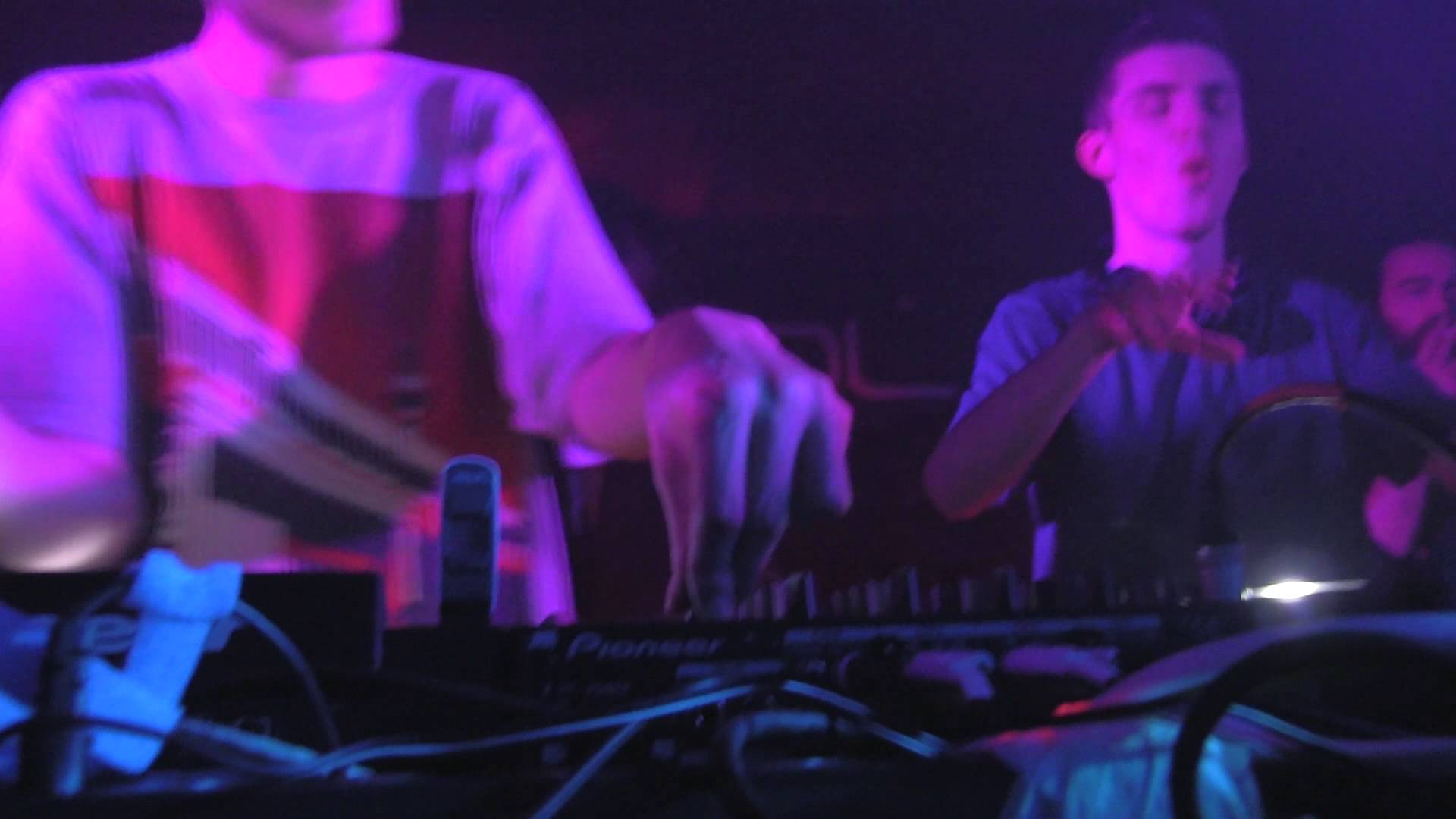
Clip 3: KOAN Sound, "Blue Stripes" (2011).
Screenshot from: "KOAN SOUND - SPANISH LOVE @ SALA BE COOL - 2.28.2014" by glenjamn3 / CC BY 3.0.
The disjuncture between technical measures and aural experience of sound calls to mind Katherine Fargo Ahern's metaphor of "tuning" in sound pedagogies. Focusing on listening and reception rather than sound itself, Ahern's pedagogy privileges neither the perception of objectively acoustic parameters (including tone, pitch, volume, and so on) nor the subjectivity of phenomenal experience. When her students listen for the non-discursive aspects of sound and music, Ahern frames the discussion as a deliberate blend of the two frameworks: "negotiation[s] of bodies, instruments, listeners, and expectations or conventions" (82)—that is, all such co-involved constituents in the holistic reception of sound. "Tuning" thus gives us an adequate framework with which to approach sonic productions featuring layers of micro samples too brief or numerous for ears to process atomically. While glitches elude intelligibility in the case of casual listening, they produce appreciable sensible consequences by affecting timbre. As Ahern demonstrates, the dichotomy between technical and aesthetic dimensions of sound is either false or of limited value.
Playing on these thresholds, the arrival and departure time of glitched samples are so quick and disjointed that they resemble a skipping compact disc. Indeed, this is how some early glitch music was created in the case of the producer Oval, whose discography is commonly cited as pioneer work in 1990s glitch music (Clip 4). Integrating glitch into meter is, as we said above, a simultaneous appeal to both experimental and conventional sensibilities. Considered alongside the work of producers associated with experimental music "proper," these tracks sound relatively well behaved. Take, for instance, the glitches of Ryoji Ikeda (Clip 5), whose stunning audio-visual installations are internationally renowned.
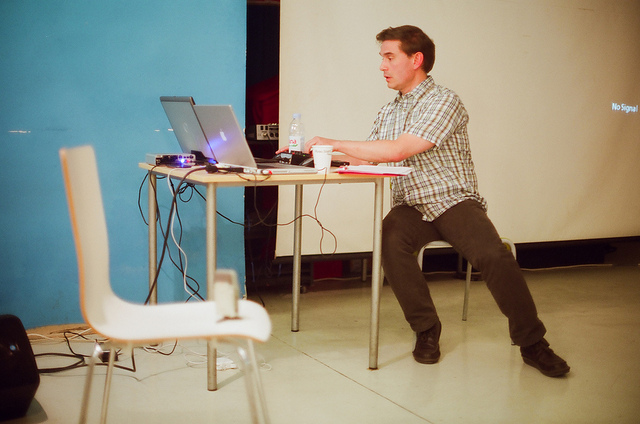
|
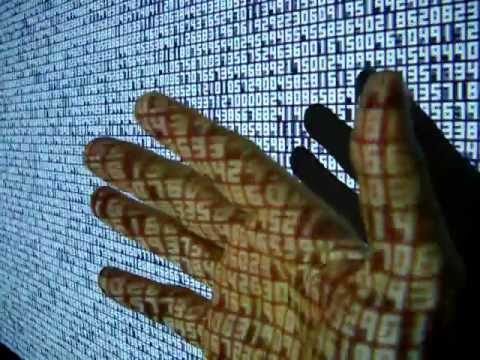
|
All the above suggests a muddled "who's who" with regard to insiders, outsiders, and mobile producers traversing both popular and experimental worlds. I posit dubstep as this third sort of outsider art on the mainstream inside. My intent is therefore to collapse the distinction by suggesting the rhetorical strength of the art is precisely in a collision of these two supposedly distinct appeals: intelligibility during meter and sensibility during novel timbres.5
Some strains of digital music have perceived themselves as liminal since their inception. Kim Cascone's landmark article, "The Aesthetics of Failure: 'Post-Digital' Tendencies in Contemporary Computer Music," ushered in the work of electronic artists who embraced hiccups and errors in digital audio production. These artists reveled in the mutated audio emitted during the crashes and stalls of editing software, understanding such errors as creations instead of scraps. As Cascone observes, the tools of electronic music composition not only streamline production, but "digital technology [also] enables artists to explore new territories for content by capturing and examining the area beyond the boundary of 'normal' functions and uses of software" (14, emphasis added). His essay features deliberate breakdown as an inventional mood:
It is from the "failure" of digital technologies that this new work has emerged: glitches, bugs, application errors, system crashes, clipping, aliasing, distortion, quantization noise, and even the noise floor of computer sound cards are the raw materials composers seek to incorporate into their music. (13)
Importantly, the impetus for all this noise is a kind of willed liminality on the part of the producers: "while technological failure is often controlled and suppressed—its effects buried beneath the threshold of perception—most audio tools can zoom in on the errors, allowing composers to make them the focus of their work" (13, emphasis added). For Cascone, failure is a series of forking pathways to new sonic aesthetics.
Following Lyotard and Ulmer in search of interpretive free play, I take EDM as a flirtation with such modulation. Texts that encourage and instigate feelings of breakage, mutation, and experimentation as part of their reading-listening-feeling experience seek out and promote innovative modes of experiencing arts and rhetorics. As liminal, EDM seems deserving of an engagement that resists the temptation to reduce the art to a list of recurring attributes, although this is perhaps the only place we can start.
A Sonic Rhetoric of Electronic Dance Music?
Surprise?
In Counter-Statement, Kenneth Burke remarks that "suspense is the least complex kind of anticipation, as surprise is the least complex kind of fulfillment" (36n4). Read literally, he's right. One can hardly experience the fulfillment of an expectation one does not hold. But what if one sets an agenda for experimentation? What if one's hope is to enter the liminal, to tinker with the unfamiliar for the purposes of invention? I neither wish to fight a straw man, nor argue with Burke's hierarchy of complexity. My purpose in citing Burke is rather to suggest that dubstep producers are less concerned with "the creation of an appetite . . . and the adequate satisfying of that appetite" (31) than with the discovery of appetites they were not aware they held—or even knew existed. Producers of dubstep and some other EDM genres seem to have an aesthetic preference "closer to invention than verification," to repurpose Gregory Ulmer's words from a different but related context (Heuretics xii).
Liminality calls to mind Ulmer's discussion of collage and montage as "post-critical." Using heterogeneous elements "cut out and pasted into new, surprising, provoking juxtapositions" (Ulmer, "Object" 85), collage is a recombinant composition in which the traditional function of signification is altered to one not primarily concerned with referentiality. Ulmer's linkage of the form to Derridian "grammatology" suggests that collage "does not abandon or deny reference, but re-thinks reference in another way: 'It complicates the boundary line that ought to run between the text and what seems to lie beyond its fringes, what is classed as the real'" (qtd. in Ulmer 87, original emphasis). Given that collage can rely on reference for the sake of juxtaposition, referentiality is not irrelevant; still, collage can elevate texture and materiality to an equal if not higher status than the conceptual realm "beyond" the work itself. For Ulmer, collage shifts away from "representation by the metaphysics of 'logocentrism,' the era extending from Plato to Freud (and beyond) in which writing (all manner of inscription) is reduced to a secondary status as 'vehicle,' [and] in which the signified or referent is always prior to the material sign, the purely intelligible prior to the merely sensible" (87). Grammatology transposed for music might dispense with tonality as a guiding melodic parameter. Dubstep features sounds not as differential, melodic operators, but as textures in their own right.
12th Planet's "Corner Pocket" and Downlink's "Factory" are good examples of such compositions (Clips 6 and 7). These works seem to rely on something other than latent, relational significations in a tonal network, foregrounding the timbres themselves.
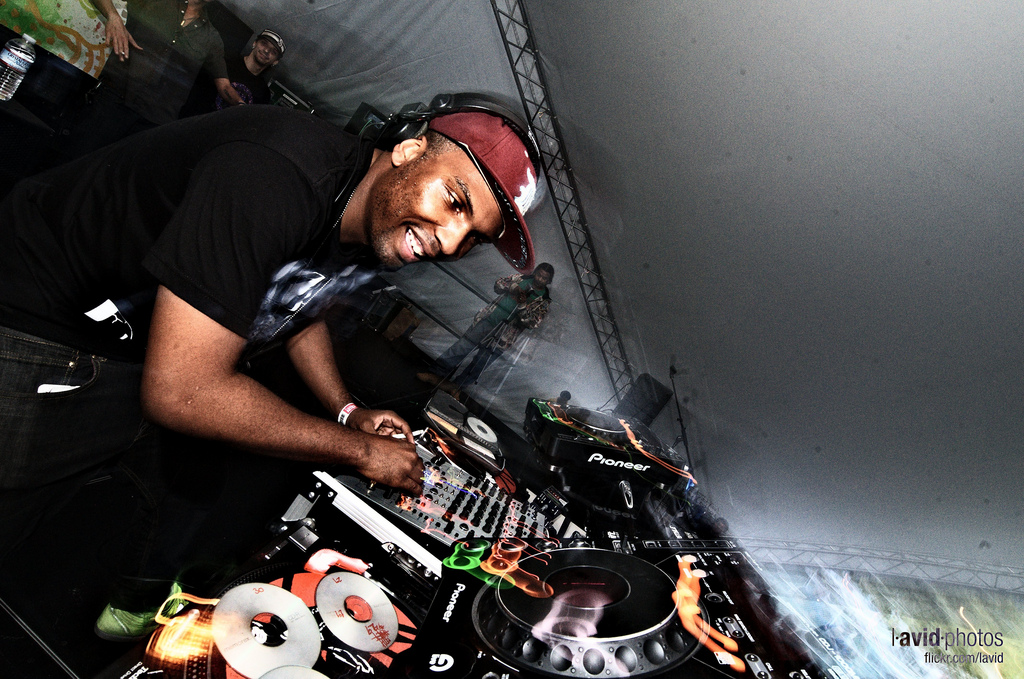
|
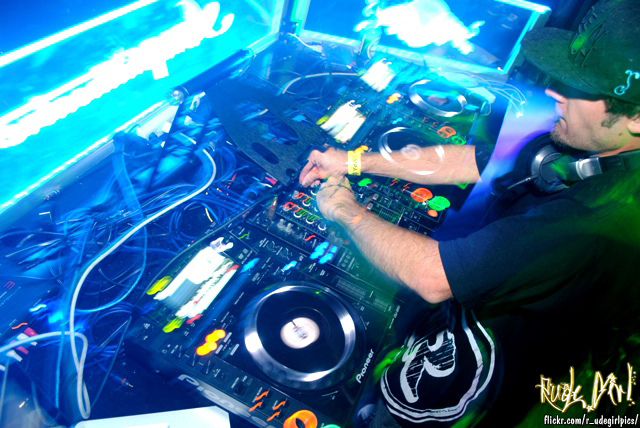
|
These samples dispense with popular music's tonal gold standard, which is loosely analogous to language as a system of differences prior to deconstruction. In music theory, the distance between notes on the staff measured in "intervals" or "steps" determines consonance or dissonance among notes and is also the basis of scales and key signatures. Instead of and/or alongside melodic phrases governed by tonality, these clips offer an aesthetic of surprise by combining an eclectic array of sound samples. And the compatibility of Ulmer's grammatology with Cascone's aesthetics is striking, particularly when the latter describes the composing process of early glitch music: in a sense, "[t]he 'atomic' parts, or samples, used in composing electronica from small modular pieces had become the whole" (17). For Cascone, glitch music is "composed of stratified layers [of samples] that intermingle and defer meaning until the listener takes an active role in the production of meaning" (17). Such a listening experience is a key change in the relationship between knower and known characterized by a forfeiture of expectation and an embrace of sonic texture itself.
Stammer?
In The Archeology of Knowledge, Michel Foucault describes a historiographical shift. "Attention has been turned," he writes, "away from vast unities like 'periods' or 'centuries' to the phenomena of rupture" and "discontinuity (threshold, rupture, break, mutation, transformation)" (4; 5). For him, the task is no longer tracing stable lines in thought, politics, philosophy, arts, and so on, but rather charting genealogical understandings of how such discourses are paradoxically substantiated by disjunctives tossed out in favor of these very stabilities. In so doing, he insists that scholars take up a different relationship with archive, which itself must be reinvented in order to adequately engage rupture. The result is a strange imperative: "suspend the continuous accumulation of knowledge, interrupt its slow development, and force it to enter a new time" (4). In so doing, Foucault was perfectly aware, researchers may stammer in attempt to register something heretofore inarticulable or disallowed precisely because it renders a field's trajectory discontinuous.
Songs like Krewella's "Feel Me" and Kill the Noise's "Talk to Me" stammer (Clips 8 and 9). As we hear in both samples, this effect is often accomplished by dicing vocal tracks and rearranging the bits in fragmented syncopation.
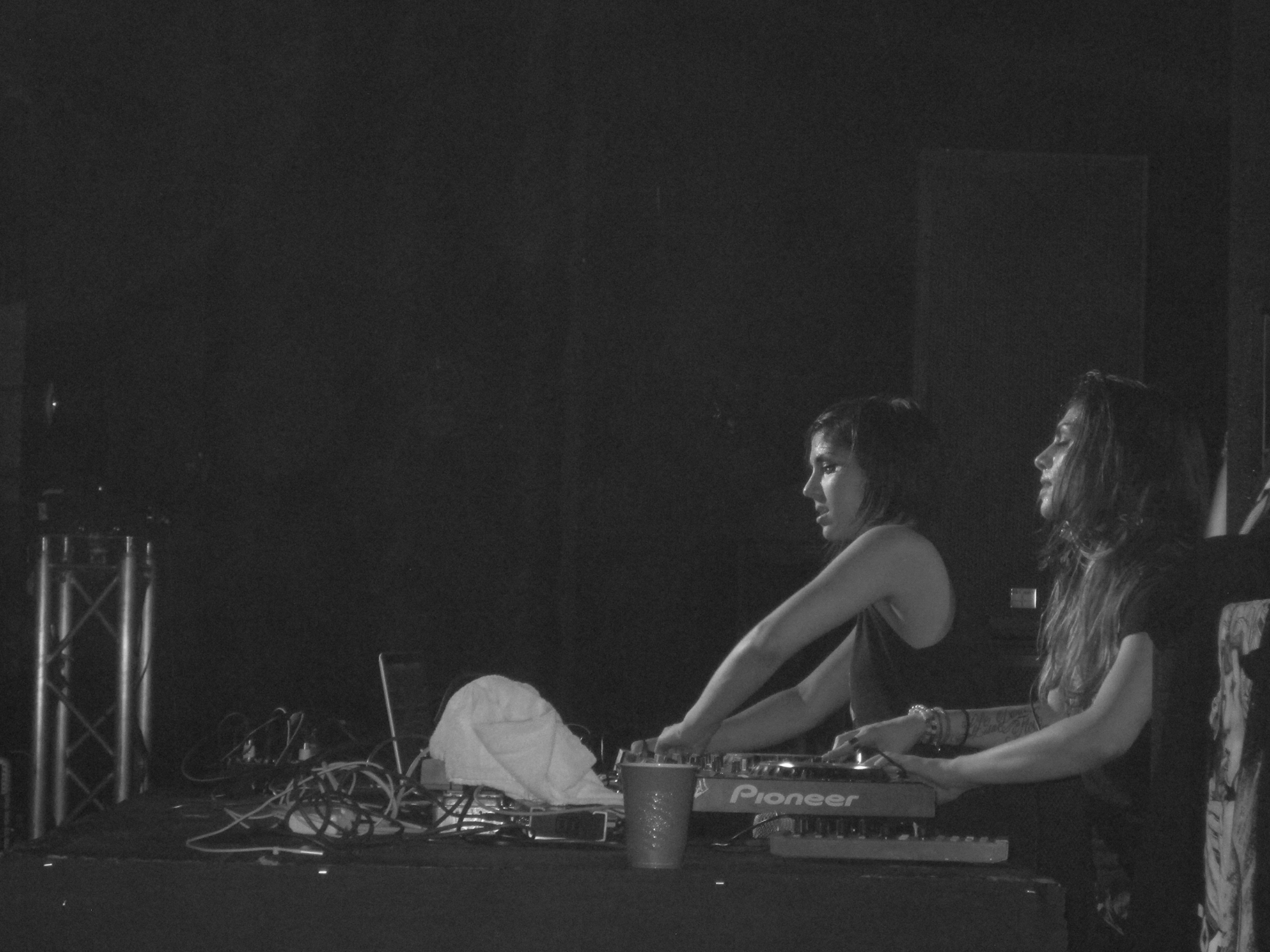
|
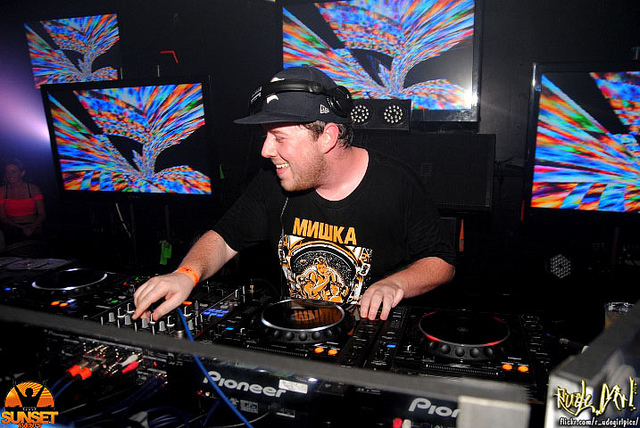
|
The result evokes interrupution, and these two clips sound as though they can hardly contain themselves. Notice the exact rhythm of the "verse" in both samples is rarely if ever repeated; each bar of the cited passages (un)usually offers a unique rhythmic phrase. Recalling the sequence from memory is, I think, deliberately made difficult, and as such a stammering aesthetic could be read as an attempt to brush up against articulable limits.
Wobbling?
Hayden White conceives of ideal argument as a "diatactic" movement. He prefers this term to dialectic, which "too often suggests a transcendental subject or narrative ego [that] stands above the contending interpretations of reality and arbitrates between them" (4). A diatactical orientation, on the other hand,
does not suggest that discourses about reality can be classified as hypotactical (conceptually overdetermined), on the one side, and paratactical (conceptually underdetermined), on the other, with the discourse itself occupying the middle ground that everyone is seeking [i.e., a dialectical synthesis]. On the contrary, discourse, if it is genuine discourse—that is to say, as self-critical as it is critical of others—will radically challenge the notion of the syntactical middle ground itself. (4)
Such a middle ground, after all, cannot exist except as a reterritorialization. How might White's "metadiscursive reflexiveness" sound? Dubstep is known for its cultivation of an aesthetic known as "wobble," a tremolo-like modulation effect usually achieved by means of oscillating the parameters of an effect filter applied to a sound-sample in real time and rhythmically looping the output. "Boogie Knights" by Butch Clancy and a remix of Diana Vickers' "Sunlight" by Adventure Club may serve as examples of especially wobbly tracks (Clips 10 and 11).

Clip 10: Butch Clancy, "Boogie Knights" (2012).
Image, released by Clancy to the internet along with The Freebies audio files, appears here courtesy of artist Mathieu St-Pierre.
The cover art's background is cropped from St-Pierre's Melting Ice Cream 6 (2013).
Such wobbling is generated with technique called "low frequency oscillation," which temporarily amplifies a select window of a sound's low-end frequencies as it is sampled. The procedure is roughly analogous to sweeping the "low" dial of a stereo's equalizer during playback for real-time modulation. Importantly, the result is not a modulated sound, but a sound being recurrently modulated in the present. Although machinically rhythmic, the result feels precarious because the timbre wavers in time.
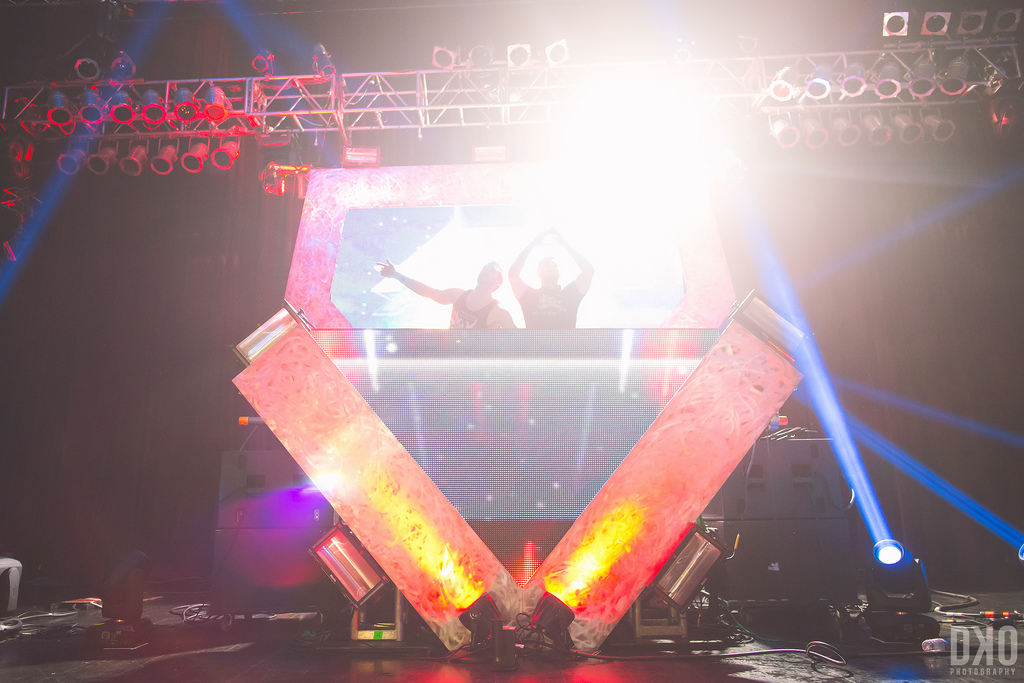
Clip 11: Diana Vickers, "Sunlight" (Adventure Club Remix) (2012).
Image: "Adventure Club & DVBBS in BOSTON" by Dylan O'Dowd / CC BY-ND 2.0.
Effects and consequent affects riding on such crests of frequency necessitate a sort of interpretative improvisation, and one recalls associated threshold experiences described by anthropologist Victor Turner: "interval[s], however brief, of margin or limen, when the past is momentarily negated, suspended, or abrogated, and the future has not yet begun, an instant of pure potentiality when everything . . . trembles in the balance" (44). Whether the dance music cited here (which is nothing if not bourgeois) instigates quite this degree of instability is dubious. Regardless, if we need and desire sonic rhetorics to transform our modes of thinking, listening, and sounding, then relevant aural suspensions should be acknowledged.
Glitch
Experimental music is by no means a new phenomenon. It predates EDM by a long shot. Here, then, I will switch and trip the flow of the essay by claiming that the cursory discussion of attributes I outlined above does not in fact amount to a viable "rhetoric of electronic dance music." I surmise that what sustains audience interest in EDM is that each surprise, stammer, and wobble is something different—by which I hope to indicate something grander and yet subtle relative to the banal (though important) idea that individual texts from any one genre are each themselves different. Instead, the claims are that if anything is "signified" or "represented" in electronic dance music, it is liminality itself in which all interpretive bets are off. The purpose, perhaps, is to "intervene in the world, not to reflect but to change reality" (Ulmer, "Object" 86). Hence, the questions: how, in light of its surprising "tendencies," should we treat experimental music in scholarly discourse—and why would it matter for rhetoric?
Prior to, beyond, or perhaps in excess of our intelligible relationship with rhetorics as identifiable means of persuasion, there also exists a relatively unwieldy dimension of engagement with rhetorics, less intelligible than merely sensible.6 This qualitative distinction becomes especially important if the issue is liminal experiences in arts and rhetorics. Next, then, I pull the ground out from under my own argument thus far—I glitch it—for the purpose of demonstrating that what is needed and wanted for experimental discourses on experimental rhetorics is to actually enact and perform these sorts of experiences—in addition to simply discoursing "about" such experiences. The subject is now how to think and write notions, moods, attitudes, and affects associated with sonic experimentation.
Musical Aesthetics, Durational Rhetorics
Consonances among music, time, and interpretation as a specifically durational activity have, in different ways, been of interest to rhetoricians. I am in tune with Steven B. Katz, for example, who highlights the fact that reading, like music, occurs during time. His is "a temporal philosophy based on harmonic association and holistic synthesis of thought and feeling rather than sequential extraction and hierarchical differentiation of meaning" (xii) we might get through static referentiality. Katz's suggestion is not simply that music can be rhetorical; rather, rhetoric can be—or is—musical in the sense of being durational, lived, and experiential. Here, my attempt will be to underscore the temporality of the present argument by means of enacting a glitch. It is not that the typology of generic attributes I outlined above is wrong or unhelpful; such taxonomy may well be a necessary basis from which to begin discoursing. But such categorical information as mere data is somewhat detemporalized, tempting one for precisely this reason to bandy it about as somehow final, closed, or exportable to new contexts without experiential specificity (see n2, below).
Rhetoricians have also argued that music can have a "worlding" capacity to not only reflect but actuate and propel existential chronologies. From Wagner to Yes to Brian Eno, Thomas Rickert and Michael Salvo suggest that evolutions in music not only reflect or parallel but also inspire transformations of our relation to the art and the world in which it appears. Specifically, they notice that accelerations in new media composition technologies can prompt both artists and audiences to ponder their relationships with music, which is especially pronounced in "a culture that is less resonate with interpretation than with engagement" (296). Relatedly, Byron Hawk's analysis of the punk band Refused suggests that pioneerings in music "se[t] the emergent ground for the rhetorical affects and future paths they make possible through their work of art" (17). What I take from these writers is a cumulative feeling that experimental ventures in music may afford an opportunity not merely for persuasion in the usual sense of making appeals to existing paradigms and satisfying established formal appetites, but can also occasion a dramatic alteration of aesthetic preferences or even reveal new "preferences" or desires not yet formulated by audiences. In the case of the present writing, aesthetics of electronic dance music cited here seem almost insatiable and even adolescent in their apparent desire for gushing novelty in timbre.
Rickert argues that ambient music is conducive less to intelligible analyses than "attunement" or mood based engagement. He notes that ambient music "eschews melody," a major dimension of grounding for popular Western music, "in favor of slowly unfolding harmonic textures . . . designed to withdraw from direct attention and permeate one’s overall environment" (133). Transposed for rhetorics, ambient music's departure from catchy, melodic qualities of popular music helps us think of an engagement with arts and rhetorics with greater specificity relative to a placeless, atemporal intelligibility. While the varieties of EDM sampled in this essay are scarcely comparable to ambient music, the relations among the experiencing subject, the art, and cultural attitudes toward electronic dance music are nevertheless compatible with and yet distinct from Rickert's rhetoric. It is argued throughout his book that an overreliance on deliberation and intentionality in rhetorical studies has necessarily resulted in a selective rendering of the field and a privileged salience. I sense a related exigency available in, through, and during electronic music given its emphasis on idiosyncrasy in timbre that seems to invite engagement without a requisite of "interpretation" in the sense of recognizing melodic patterns. The difference, however, is that EDM pairs regularity with irregular texture and thus fuses noise with the clarity of rhythm. While its audiences accept experimentation in the parameter of timbre, they demand blunt periodicization on the beat for an ironic fusion of abandon and constraint.
Experiment and Integration: Noise, Glitch, and Failure
Before closing, I would like to make a metadiscursive comment on the multitudinous aesthetics of experimental electronic music that have gone under the scholarly headings of "noise," "glitch," and "failure." Readers familiar with such aural arts will be quick to note that the samples of popular EDM cited earlier differ enormously with this trio of experimental strains. My claim is not for a similarity of textural aesthetics, but a partial compatibility of desires for timbre in the efforts of EDM and dubstep in particular.
My particular interest is the special handling required in light of the semantic ironies that arise when the objects of scholarly discourse are artworks that would hope to be experimental or scramble existing aesthetic classifications. One of the first issues that arises in defining any member in this trio of noise, glitch, and failure as an aesthetic entity is whether any of these can or should be considered "music." Douglas Kahn approaches the issue with the subtly and care it requires in his 1999 book Noise Water Meat. The title is a nod to the unlikely materials and mediums with and in which the Italian Futurists, John Cage, William Burroughs, and others disrupted conventional music of their days by integrating novel and, if you like, raucous production techniques. These artists and thinkers brought sounds like industrial machinery, teapots, and even the body's capacity to register and emanate nonvocal sound to bear on our understandings of musical, aesthetic, and affective experience. Kahn therefore begins instead with "sound" as any "auditive phenomena"—real or imagined, audible or dreamed. Apropos of experimental or avant-garde arts movements, then, the first step in conceiving noise as art is to consider this general sense of sound as art, if only because made "significant" or "musicalized" by the artists, as Kahn puts it (3-4).
In terms of noise, the historical texts most significant for Kahn are the separate compositions of Italian Futurist musicians Francesco Balilla Pratella and Luigi Russolo. Each penning essays in the genre "manifesto," both Russolo and Pratella are polemic in bemoaning what they saw as complacency in the textural aesthetics of Italian music in the early part of the twentieth century. In The Art of Noises, first published in 1913, Russolo proclaims "musical sound is too limited in its variety of timbres" and urges his contemporaries to diversify the very notion of music: "we must break out of this limited circle of sounds and conquer the infinite variety of noise-sounds" (28, original emphasis). Russolo is remembered specifically for his "intonarumori" devices, with which he actually and deliberately did pursue the chaotic sonics of contemporary industrial machinery (Clip 12).
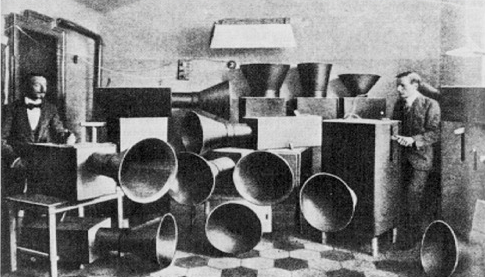
Clip 12: Rusollo, "Risveglio Di Una Città" (1913).
Image from Russolo's The Art of Noises (1913) is in the public domain under PD-1923.
The artist (left) appears with his "intonarumori" devices and the painter Ugo Piatti (right).
Pratella's "Manifesto for Futurist Musicians" is specifically addressed to "the young, who are necessarily athirst for things that are new, alive, and contemporary" (75). The text encourages readers to abandon schools of music and create noise independently because such institutions promoted tradition and conservatism in art (Pratella 79). While Pratella and Russolo clearly position themselves as loud and proud—virtuous because disruptive—Kahn points out a (not so?) subtle irony in their posture: "with so much attendant on noise it quickly becomes evident that noises are too significant to be noises" in the common sense of being unwanted—or, at least, too significant to be thought unwanted (21). Battlecries for "conquer[ing]" sounds might even feel, as Tara Rodgers argues, less about aesthetic freewheeling than a spirit of command and mastery associated with technological if not "militaristic" control found in Futurist writings (475-476). What appears to be a straight forward split between noise and music, then, is for both the Futurists and Kahn, superfluous—but for different reasons. The conception of noise in an antagonistic or contrarian relationship with music seems to position the former as somehow outside the latter. But Kahn's insight is that the phenomenon of musical noise, especially as it developed from the early part of the century to the experimental arts movements in America during the 1950s and 1960s, is typically addressed in terms of attention, salience, and reintegration.
This line between sound and musical sound stood at the center of the existence of avant-garde music, supplying a heraldic moment of transgression and its artistic raw material, a border that had to be crossed to bring back unexploited resources, restock the coffers of musical materiality, and rejuvenate Western art music. (Kahn 69)
While zeitgeist among the Futurists and other progressives like John Cage, Fluxus, and the Happenings collectives in the mid-twentieth century called for an ambiguous and open-ended venture into that which disoriented, Kahn suggests they always did so with the intent of returning from the journey to exhibit and thus make salient newfound textures. Such a claim downplays, at least to some extent, the qualitative difference in experimentation of popular EDM artists and those who do so for explicitly counter-cultural reasons. The idea of Russolo and Pratella as subversive minoritarians is somewhat complicated here because, while cultures are not monoliths, (sub)cultures are cultural.
Returns, Critiques
The unshakable irony permeating even the present essay, of course, is that glitch, noise, and failure as "an aesthetic" to be recognized, held up, critiqued, or celebrated has undermined their disruptive edges. Cascone himself makes an interesting pivot a decade after the publication of his perennial essay in a talk he titles "The Failure of Aesthetics." He laments what in retrospect seems like the inevitable appropriation of glitch aesthetics by mainstream media:
Video 1: From "Kim Cascone - The Failure of Aesthetics"
Uploaded by PIEMONTE SHARE / CC BY 3.0. Cut from original.
The problem is that what appeared to be a direct challenge to grammatical and overly familiar modes of artistic production has itself, perhaps inevitably, become grammaticized. By the end of his talk, however, he seems hopeful in challenging artists to once again move beyond trope and typification—to engage in yet more stretching. In his view, the appetite for innovation cannot be satisfied by reliance on techniques or streamlined aesthetic tendencies already dominant in electronic music. After all, it is not as if glitch as such is susceptible to coopting.
Full Squiggle
My attempt here has been to glitch the critical manuscript for the sake of leaving open not only the aesthetic potentialities of electronic music but also rhetoric's approaches-to and relationships-with sonic "objects" in academic writing. Predicated on timbre as a rhetorical and aesthetic parameter, I have oscillated between "experimental" music on the one hand and "popular" dance music on the other in order to establish some ways in which this apparent dichotomy is false. Still, given the recent fanfare surrounding EDM cultures, the question remains: just how experimental are these electronic dance music artists? To what extent are these producers simply catering to popular or general audiences with predefined, albeit newly minted, expectations?
One response to such questions might observe that what constitutes "experimental" is always contextual. With its emphasis on textural experience through idiosyncratic timbre, dubstep attempts to satisfy appetites listeners may not know they possess. And yet, undeniably, these same fans crave and take comfort in the security of certain tropes, most notably the common 4/4 time sustained in a highly regimented fashion. Often the same meter appears throughout the entirety of a song or even across whole albums. Hardly experimental(?). I would see this apparent juxtaposition of experimentation and regularity as an attempt to point outside from inside, a catering to an oscillation of appetites for both stasis and divergence. All this is not unlike the field's present situation, that is, sonic rhetoric's liminal moment of burst and bloom. Its currency is at least partly backed by novelty in meaning making and the very newness of sonic rhetorics the discipline is currently exploring.
Lines of metadiscourse begun here might be continued for stylistic idiosyncrasies in further genres, electronic and otherwise. But the key issue for rhetoricians is a possible shift in the critic's relationship to sound that would be novel or experimental. My hope for this essay is that its performative engagement with timbre amounts to one such contribution. Come what may, preserving the element of surprise manifest in sonic howls, yawps, and glitches will be of the utmost importance. Without it, their innovations may be somewhat muted.
Notes
1. Quantitatively accounting for timbre involves measuring "overtones" in a "harmonic series" of a sound. When a tone sounds, what is emitted is not only the "fundamental" or specified note but also a relatively faint blend of overtones at higher frequencies known as a harmonic series (Jacobs 160). Patterns in frequencies correlate to differentiations in timbre (Jacobs 379)—e.g., "bright"; "muddy"; "raspy"—but it is somewhat awkward to suggest that overtones produce timbre exclusively, given that timbre is also dependent on acoustic environments, receptive bodies, the physical fabrication of stereo hardware and instruments, etc. Even in the case of early synthesizers, when the precise distribution of overtones to be emitted in each case was known and programmed in advance, the ultimate experience of sound for most casual listeners is only ever temporal and embodied.
In appealing to the phenomenological experience of sound, I hardly intend to invoke a transhistorical subject as critiqued, for example, by Jonathan Sterne (13-15). I simply note that numeric representation of sonic energy and the bodily register of sonic phenomena necessitates a meta/physical threshold—historically situated bodies notwithstanding.
2. My use of the term "genre" is in line with Carolyn Miller's understanding of the concept in her article "Genre as Social Action." Following Miller, my interest will not be in recurring substances (semantics) or forms (syntactics) of music. Instead, the article will be oriented by a "an understanding of how discourse works—that is, [how] it reflects the rhetorical experience of the people who create and interpret the discourse" with certain actions or purposes in mind (Miller 152). While I will begin with recurring textual and textural attributes of the music, my ultimate concern will be the affective experience of timbre and how audiences not only taxonomize but relate with "new" sounds in particular.
3. Rice juxtaposes this theory of "digital aurality" he dubs "ka-knowledge" alongside the historically "topos based" model of literate knowing, which is characterized by a "fixed place of meaning" (276).
4. Such a claim might irritate some readers because it conflates so called "popular" dance music with "experimental" arts. While there is certainly a sense in which arts and rhetorics might aim for mere "gratification and pleasure"—"flattery," perhaps (Plato 97)—this popular/experimental divide is rather coarse. I reject this false dichotomy as we proceed.
5. My gesture here is inspired by Victor J. Vitanza's attempt to be "an outsider while inside" when writing histories of rhetorics (19). His topographic model is the Klein jar, a non-orientable surface "which is all outside and no inside, or which is neither" (7).
6. The distinction between sensibility and intelligibility here invokes one of the longest and most contentious dialectics in the history of Western thought. Related pairings include aesthetic/epistemic, feeling/meaning, experiencing/knowing, and so on. This article, much less this endnote, is hardly the place to unpack related genealogies. Suffice it to say that positioning these terms as strict antitheses would be unsophisticated.
Notes on the fair use of copyrighted materials, organized by the criteria of judgement set forth in Title 14 Chapter 1 §107 of the U.S. Code:
1. Purpose and character of the use of copyrighted works: The works are sampled here for the purpose of citation in a scholarly analysis (and for the sake of exalting the aesthetic achievements of the artists). The samples are explicitly discussed as the works of others and should not be construed as writer's own inventions.
2. Nature of the copyrighted works: While the partially reproduced works are creative in nature, the present writing and its scholarly venue of publication are qualitatively different such that the creativity of the present writer is manifest in a different medium.
3. Amount and substantiality of the portions used in relation to the copyrighted works as a whole: Samples of the copyrighted works are fractions of the original works. The full range and development of the copyrighted works cannot be heard in the clips included here.
4. Effect of the use upon the potential market for or value of the copyrighted works: The clips in this essay are poor substitutes for the original works, even considering the fact that EDM culture is associated with sampling. Still, clips are so brief as to be impractical for personal listening outside of the noncommercial, educational reading promoted here. All source files for this project were either purchased from legal vendors or made freely available by the creators online.
Discography
12th Planet. "Corner Pocket." Who Are We EP, SMOG Records, 2011.
Adventure Club. Remix of "Sunlight" by Diana Vickers. SoundCloud, uploaded by Adventure Club, 2012, https://soundcloud.com/adventureclub/diana-vickers-sunlight.
Butch Clancy. "Boogie Knights." SoundCloud, uploaded by Butch Clancy, 2012, https://soundcloud.com/butchclancy/boogie-knights-free-download.
Datsik, "Hydraulic." Hydraulic / Overdose, Rottun Recordings, 2011.
Downlink. "Factory." Factory / Yeah, Rottun Recordings, 2011.
Ikeda, Ryoji. "Supercodex 04." Supercodex. Raster-Noton, 2013.
KOAN Sound. "Blue Stripes." Dubstep Onslaught, Z Audio, 2011.
Kill the Noise. "Talk to Me." Kill Kill Kill, OWSLA, 2011.
Krewella. "Feel Me." Play Hard, Krewella Music LLC, 2012.
Oval. "Shop in Store." 94 Diskont, Thrill Jockey, 1996.
Russolo, Luigi. "Risveglio Di Una Città." UbuWeb, uploaded by UbuWeb, n.d., http://www.ubu.com/sound/russolo_l.html.
Skrillex. "Rock n' Roll (Will Take You to the Mountain)." Scary Monsters and Nice Sprites, Big Beat Records, 2012.
Works Cited
Ahern, Katherine Fargo. "Tuning the Sonic Playing Field: Teaching Ways of Knowing Sound in First Year Writing." Computers and Composition, vol. 30, no. 2, 2013, pp. 75-86.
Boyle, Casey. "The Rhetorical Question Concerning Glitch." Computers and Composition, vol. 35, 2015, pp. 12-29.
Burke, Kenneth. Counter-Statement. U of California P, 1968.
Cage, John. Silence. Wesleyan UP, 2011.
Caramanica, Jon. "Waves of Sound, Wobbles of Bass." The New York Times, 21 Sep. 2009, https://nyti.ms/2xJJbzx. Accessed 22 Apr. 2013.
Cascone, Kim. "The Aesthetics of Failure: 'Post-Digital' Tendencies in Contemporary Computer Music." Computer Music Journal, vol. 24, no. 4, 2000, pp. 12-18.
---. "Kim Cascone - The Failure of Aesthetics." Vimeo, uploaded by PIEMONTE SHARE, Nov. 3 2010, https://vimeo.com/17082963.
Ceraso, Steph. "(Re)Educating the Senses: Multimodal Listening, Bodily Learning, and the Composition of Sonic Experiences." College English, vol. 77, no. 2, 2014, pp. 102-123.
Coren, Stanley, Lawrence M. Ward, and James T. Enns. Sensation and Perception. 6th ed., Wiley, 2004.
Erikson, Gregory. "Speaking of Music: Explorations in the Language of Music Criticism." enculturation, vol. 2, no. 2. 1999, http://enculturation.net/2_2/erickson.html. Accessed 4 Sept. 2017.
Foucault, Michel. The Archaeology of Knowledge and the Discourse on Language. Trans. A. M. Sheridan Smith. Vintage, 2010.
Halbritter, Bump. Mics, Cameras, Symbolic Action. Parlor Press, 2013.
Hawk, Byron. "The Shape of Rhetoric to Come: Musical Worlding as Public Rhetoric." Pre/Text, vol. 20 nos., 1-4, 2010, pp. 7-42.
Jacobs, Arthur. A New Dictionary of Music. Penguin, 1960.
Jarrett, Michael. Drifting on a Read: Jazz as a Model for Writing. State U of New York P, 1999.
Kahn, Douglas. Noise, Water, Meat: A History of Sound in the Arts. MIT P, 1999.
Katz, Steven B. The Epistemic Music of Rhetoric: Toward the Temporal Dimension of Affect in Reader Response and Writing. Southern Illinois UP, 1996.
Koehler, Adam. "'Frozen Music, Unthawed': Ka-Knowledge, Creative Writing, and the Electromagnetic Imaginary." enculturation, vol. 7, 2010, http://enculturation.net/frozen-music-unthawed. Accessed 4 Sept. 2017.
Levy, Matthew A. "Shhhh! Or, the Methodological Earplugs of Cultural Studies in Popular Music: A 'Re‐Sound' of Swiss, Sloop and Herman's Mapping the Beat." Review of Mapping the Beat, by Thomas Swiss, John Sloop, and Andrew Herman. enculturation, vol. 2, no. 2, 1999, http://enculturation.net/2_2/levy.html. Accessed 4 Sept. 2017.
Lyotard, Jean-François. The Postmodern Condition: A Report on Knowledge. Translated by Geoff Bennington and Brian Massumi, U of Minnesota P, 1984.
Miller, Carolyn R. "Genre as Social Action." Quarterly Journal of Speech, vol. 70, no. 2, 1984, pp. 151-167.
Plato. Gorgias. Translated by W. R. M. Lamb, The Rhetorical Tradition: Readings from Classical Times to the Present, edited by Patricia Bizzell and Bruce Herzberg, Bedford, 2001, pp. 87-138.
Pratella, Franceso Balilla. "Manifesto of Futurist Musicians." Futurism: An Anthology, edited by Lawrence Rainey, Christine Poggi, and Laura Wittman, Yale UP, 2009, pp. 75-80.
Rice, Jeff. "The Making of Ka-Knowledge: Digital Aurality." Computers and Composition, vol. 23, no. 3, 2006, pp. 266-279.
Rickert, Thomas. Ambient Rhetoric: The Attunements of Rhetorical Being. U of Pittsburgh P, 2013.
Rickert, Thomas and Michael Salvo. "The Distributed Gesamptkunstwerk: Sound, Worlding, and New Media Culture." Computers and Composition, vol. 23, no. 3, 2006, pp. 296-316.
Rickert, Thomas and Byron Hawk. "'Avowing the Unavowable': On the Music of Composition." enculturation, vol. 2, no. 2, 1999, http://enculturation.net/2_2/intro.html. Accessed 4 Sept. 2017.
Rodgers, Tara. "Toward a Feminist Historiography of Electronic Music." The Sound Studies Reader, Edited by Jonathan Sterne, Routledge, 2012, pp. 475-489.
Russolo, Luigi. The Art of Noises. Translated by Barclay Brown, Pendragon, 1986.
Selfe, Cynthia L. "The Movement of Air, the Breath of Meaning: Aurality and Multimodal Composing." College Composition and Communication, vol. 60, no. 4, 2009, pp. 616-663.
Shipka, Jody. "Sound Engineering: Toward a Theory of Multimodal Soundness." Computers and Composition vol. 23, no. 3, 2006, pp. 355-373.
Sterne, Jonathan. The Audible Past: Cultural Origins of Sound Reproduction. Duke UP, 2003.
Turner, Victor. From Ritual to Theatre: The Human Seriousness of Play. PAJ, 1982.
Ulmer, Gregory L. Heuretics: The Logic of Invention. The Johns Hopkins UP, 1994.
---. "The Object of Post-Criticism." The Anti-Aesthetic: Essays on Postmodern Culture, edited by Hal Foster, The New Press, 1983, pp. 83-110.
Vitanza, Victor J. Negation, Subjectivity, and The History of Rhetoric. State U of New York P, 1997.
White, Hayden. Tropics of Discourse: Essays in Cultural Criticism. The Johns Hopkins UP, 1978.